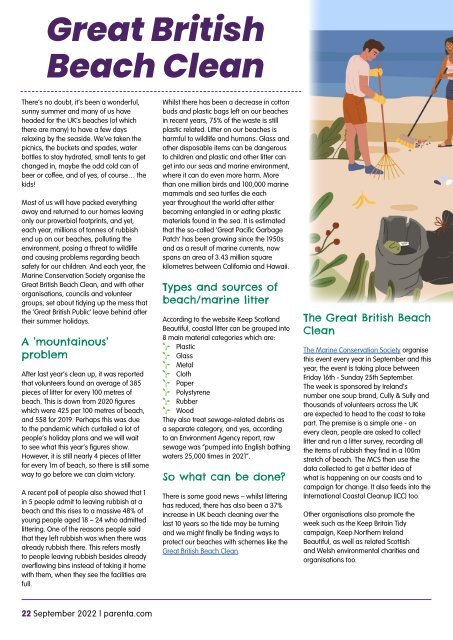September 2022 Parenta magazine
Create successful ePaper yourself
Turn your PDF publications into a flip-book with our unique Google optimized e-Paper software.
Great British<br />
Beach Clean<br />
There’s no doubt, it’s been a wonderful,<br />
sunny summer and many of us have<br />
headed for the UK’s beaches (of which<br />
there are many) to have a few days<br />
relaxing by the seaside. We’ve taken the<br />
picnics, the buckets and spades, water<br />
bottles to stay hydrated, small tents to get<br />
changed in, maybe the odd cold can of<br />
beer or coffee, and of yes, of course… the<br />
kids!<br />
Most of us will have packed everything<br />
away and returned to our homes leaving<br />
only our proverbial footprints, and yet,<br />
each year, millions of tonnes of rubbish<br />
end up on our beaches, polluting the<br />
environment, posing a threat to wildlife<br />
and causing problems regarding beach<br />
safety for our children. And each year, the<br />
Marine Conservation Society organise the<br />
Great British Beach Clean, and with other<br />
organisations, councils and volunteer<br />
groups, set about tidying up the mess that<br />
the ‘Great British Public’ leave behind after<br />
their summer holidays.<br />
A ’mountainous’<br />
problem<br />
After last year’s clean up, it was reported<br />
that volunteers found an average of 385<br />
pieces of litter for every 100 metres of<br />
beach. This is down from 2020 figures<br />
which were 425 per 100 metres of beach,<br />
and 558 for 2019. Perhaps this was due<br />
to the pandemic which curtailed a lot of<br />
people’s holiday plans and we will wait<br />
to see what this year’s figures show.<br />
However, it is still nearly 4 pieces of litter<br />
for every 1m of beach, so there is still some<br />
way to go before we can claim victory.<br />
A recent poll of people also showed that 1<br />
in 5 people admit to leaving rubbish at a<br />
beach and this rises to a massive 48% of<br />
young people aged 18 – 24 who admitted<br />
littering. One of the reasons people said<br />
that they left rubbish was when there was<br />
already rubbish there. This refers mostly<br />
to people leaving rubbish besides already<br />
overflowing bins instead of taking it home<br />
with them, when they see the facilities are<br />
full.<br />
Whilst there has been a decrease in cotton<br />
buds and plastic bags left on our beaches<br />
in recent years, 75% of the waste is still<br />
plastic related. Litter on our beaches is<br />
harmful to wildlife and humans. Glass and<br />
other disposable items can be dangerous<br />
to children and plastic and other litter can<br />
get into our seas and marine environment,<br />
where it can do even more harm. More<br />
than one million birds and 100,000 marine<br />
mammals and sea turtles die each<br />
year throughout the world after either<br />
becoming entangled in or eating plastic<br />
materials found in the sea. It is estimated<br />
that the so-called ‘Great Pacific Garbage<br />
Patch’ has been growing since the 1950s<br />
and as a result of marine currents, now<br />
spans an area of 3.43 million square<br />
kilometres between California and Hawaii.<br />
Types and sources of<br />
beach/marine litter<br />
According to the website Keep Scotland<br />
Beautiful, coastal litter can be grouped into<br />
8 main material categories which are:

















